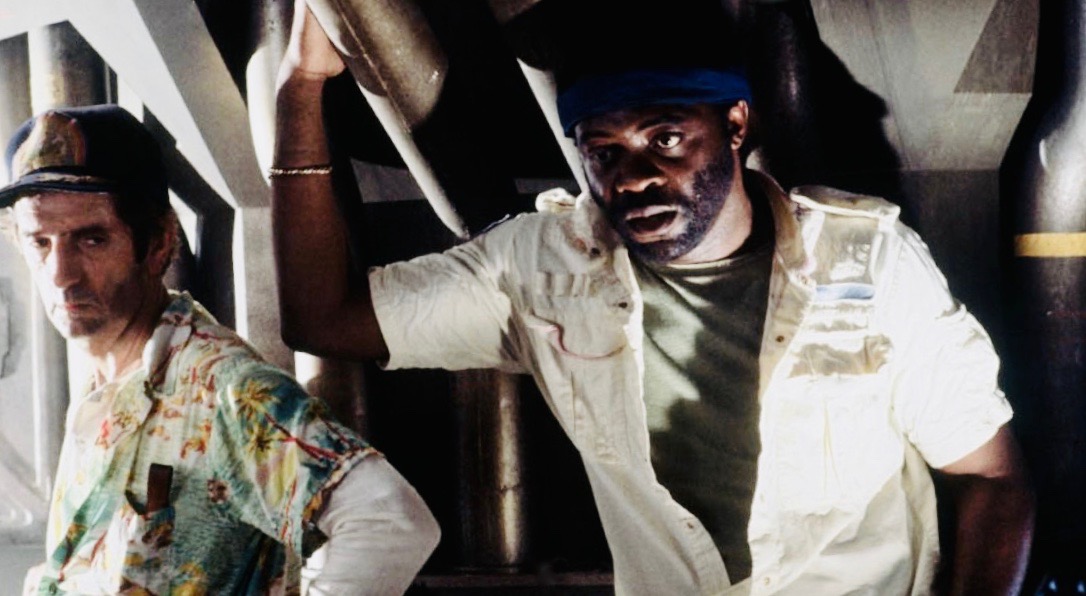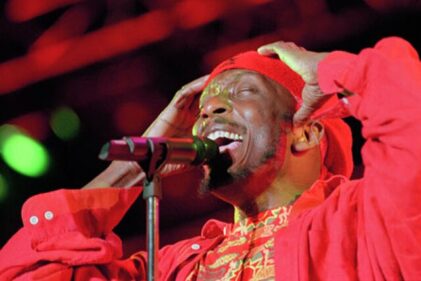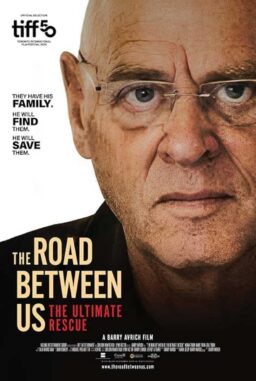Casting Yaphet Kotto made things better. That’s how it worked. Look through Kotto’s credits and try to find a bad performance. There are none. Kotto, who died in the Philippines yesterday at 81, always delivered beyond the expectations of viewers, whatever they were. He surprised the filmmakers who cast him as well. Even if the project was forgettable, Kotto was likely to be brilliant in it, bringing star power to supporting roles, and often knocking lead actors off the screen with a superior display of craft and imagination.
He was a pioneering actor in so-called “blaxploitation” films in the ’70s, playing criminals, cops, and tough guys. He had panache and commanded any room he entered. In 1970’s “Bone,” a crime thriller/domestic drama from writer/director Larry Cohen, Kotto played a criminal who takes a white couple hostage intending to empty their bank accounts but ends up getting drawn into a “Double Indemnity“-like conspiracy. In “Across 110th Street,” Kotto partnered up Anthony Quinn (also the film’s executive producer, stepping in after three other lead actors dropped out) to investigate the massacre of Mafioso and Black gangsters in a robbery. In 1972’s “The Limit,” Kotto’s only film as writer/director, he plays a straitlaced motorcycle cop patrolling crime-ridden territory with his white partner (Jeff McMillan). The difference between the three roles is drastic. Kotto would continue to surprise and confound viewers as he moved into mainstream Hollywood films and network TV projects.
Kotto played Smokey James, a hard-bitten union man, in Paul Schrader’s 1978’s “Blue Collar,” opposite Richard Pryor and Harvey Keitel, incarnating the burdens and dreams of rank-and-file auto workers—a figure who now seems legendary in the memory. He was Emmy-nominated as Ugandan dictator Idi Amin in the 1977 TV miniseries “Raid on Entebbe,” glad-handing and speechifying and carrying on for the benefit of newsreel cameras that followed Amin everywhere. He was Lt. Al Giardello on NBC’s “Homicide: Life on the Street,” the only personality big enough to boss around a Baltimore squad room full of gifted, egotistical detectives. He was FBI agent Alonzo Mosley in “Midnight Run,” Elmer Fudd to Robert De Niro’s profane Bugs Bunny, always a step behind but admiring his quarry’s hustle. Kotto was the first Black villain in a James Bond film, 1973’s “Live and Let Die,” which let him play dual roles: Kananga, the dictator of the fictional Caribbean nation of San Monique, and his alias Mr. Big, a feared Harlem gangster. Fitting that the bad guy would literally explode at the end of the picture, as that’s what you expected Kotto to do all along, so overwhelming were the twin forces of Kananga’s magnetism and capacity for violence.
And of course Kotto was Parker in the original “Alien,” representing (along with costar Harry Dean Stanton) the “Blue Collar”-styled proles on a commercial mining vessel. Parker goes out of his way to test the authority of the ship’s officers (Sigourney Weaver’s Lt. Ripley and Tom Skerritt’s Captain Dallas), quickly identifies (along with Ripley) the nature of the threat they’re facing, and demands that they come together and deal with it as soon as possible. All business, and always looking out for number one (and his buddy Brett, whom he treats as an extension of himself), Parker gets out of suspended animation at the start of the film and immediately wants to discuss “the bonus situation.”
That phrase also told you what you had on your hands if you put Yaphet Kotto in your cast: a bonus situation.
Look at the way he plays Idi Amin in the scene from “Raid on Entebbe” that introduces the character. He hadn’t just studied how the dictator spoke, walked, and gestured before arriving on set. He’d captured the studied harmlessness that Amin affected when cameras were rolling. For that matter, look at Kotto’s death scene in the 1974 Isaac Hayes thriller “Truck Turner.” It’s a seven-course meal of grandiosity, a demise worthy of James Cagney or Al Pacino. He limps, staggers, falls, gets back up, and stumbles all the way out into the street and tries to get behind the wheel of a car and drive away. The entire time you get the sense of a man coming to terms with the fact that he’s been beaten, that this is truly the end. You can see it by looking into Kotto’s eyes.
<span id=”selection-marker-1″ class=”redactor-selection-marker”></span>
His performance in “Alien” is moving and tender. Parker’s evident love of Brett is drawn from Kotto’s friendship with Harry Dean Stanton, which predated the filming by many years. Kotto said that when he set foot on the “Alien” soundstages, he realized his performance would have to be much “bigger” than he’d imagined, even “bombastic,” to prevent Parker from being eclipsed by the scale of the production and the fearsomeness of H.R. Giger’s creature designs. Kotto convinced himself that he was Parker, imperiled at every turn. In a Facebook diary published shortly before his death, he talked about doing mental exercises where he’d erase the boundary between the character and himself. He’d tell himself that he had to stay alive “to protect Veronica,” referring to his costar, Veronica Cartwright. He used to psych himself up every day by telling cast and crew, including Ridley Scott, “I’m gonna kill it, man! There’s no way it can kill me!”
Kotto later credited “Alien” with giving him a taste of a world described in the Rev. Dr. Martin Luther King’s “I Have a Dream” Speech, which he personally witnessed as a young man attending the March on Washington. Kotto wondered if, as an artist as well as a person, he would ever feel judged by the content of his character rather than the color of his skin. Two decades later, he and his eldest daughter went to Washington and found the spot where Kotto had stood. “I was telling her how, years before I stood there listening to Dr. King’s speech,” he told an audience at the Toronto Film Festival in 2003. “And a bus pulled up with a bunch of children from Japan. They got out of the bus and they ran toward me. I couldn’t understand what they were speaking, but there was one thing that blew me away, the fact that they were all saying one word: ‘Alien.'”
Kotto’s default mode was an alert, world-wise energy. It told the viewer, “This is a man who has been through a lot and learned from it and can’t be easily fooled.” Kotto communicated these qualities in 1968’s “The Thomas Crown Affair,” where he played a member of McQueen’s heist crew, and in two films by veteran Hollywood directors: William Wyler’s “The Liberation of L.Q. Jones,” and “5 Card Stud,” directed by “True Grit” filmmaker Henry Hathaway. You sense Kotto’s realness in 1980s “Brubaker,” playing a convict allied with a reformist prison warden played by Robert Redford. And you can even sense it in the 1987 Arnold Schwarzenegger science fiction thriller “The Running Man,” in which Kotto plays one of three condemned men dropped into a survivalist game show. Kotto’s tenacity and fearlessness are leavened throughout by his incredulous expressions, which could be summed up as, “I can’t believe I’m in another science fiction movie where I die, and in this one, I gotta wear a jumpsuit.”
Kotto was born in New York City to an Army nurse mother named Gladys Marie and a Cameroon businessman named Avraham Kotto, formerly Njoki Manga Bell. Kotto’s father was an African Jew who said he could trace his lineage to the Cameroon royal family. He raised Kotto as a Jew, and Kotto’s mother converted. Kotto told InsideHook that if he hadn’t become an actor, he might’ve become a rabbi. While traveling, he used to make a point of seeking out the synagogue closest to his hotel, but eventually stopped because “the rabbis want to get to know you and so forth and so on, and they constantly want you to move to wherever you are. So now I don’t look for a synagogue when I go out of town.”
Kotto got into acting as a 16-year old, studying at the Actors Mobile Theater Studio in New York. He got his first professional role at 19 in a stage production of Othello and went on to appear in The Great White Hope on Broadway. In a 2003 Austin Chronicle interview, Kotto credited Barbara Stanwyck, his costar on “The Big Valley,” and Mary Astor, who took a liking to his acting, with boosting his confidence. Stanwyck “took over my life … Brother, every move I made, she was following me.” Astor delivered regular, tough critiques of his performances. “Mary would call and say, ‘You weren’t acting. I don’t know what you call that, but that wasn’t acting,’ he told the Austin Chronicle.
Kotto was married three times during his life—finally to Tessie Sinahon, a native Filipino. He had a total of six children by his first two wives. He was a raconteur with a poetic sense of language. And he was a deeply religious political conservative, endorsing Donald Trump in 2016 and posting about QAnon on Facebook near the end of his life.
Kotto was also—as people might’ve described him in Harlem 100 years ago—a devoted “race man” who put a lot of thought into the types of roles that he sought and accepted, always considering whether the part would enlarge the industry’s sense of what actors of color could do. Kotto was especially conscious of himself being a six-foot-three inch, broad shouldered, deep voiced, dark complected Black man—a physical type at risk of being typecast as an anonymous servant, soldier, or street criminal. Kotto didn’t want that for himself. He got into acting because he idolized Marlon Brando and wanted to become the Black answer to that sort of performer: electrifying, intellectual, free spirited, with a career path that kept taking fans by surprise.
“I studied all his movies,” Kotto told SyFy Wire a few years ago. “Went to the same school he went to, the Actors Studio in New York City. Hung out with the same people. That was the only actor that existed. And I’m told he felt the same way about me. Although he once said, ‘There’s only one other person that has a strange name like mine, and that’s Yaphet Kotto.'”
Following the critical success of “Blue Collar” and the box office success of “Alien,” Kotto was on the short list to play Lando Calrissian in 1980’s “The Empire Strikes Back,” directed by George Lucas’ mentor Irvin Kershner, Kotto’s director on “Raid on Entebbe.” Kotto turned it down because he’d just done “Alien” and didn’t want to be typecast as a “science fiction actor.” He was eager to move on to “Brubaker,” a story set on earth.
Kotto was at the top of Gene Roddenberry’s wish list to play Captain Jean-Luc Picard in “Star Trek: The Next Generation,” which premiered in syndication in 1987, but he turned it down because of the science fiction stigma, and because at the time, theatrical films were still considered more prestigious than TV. If Kotto had said yes, the Federation would’ve had its first Black lead six years earlier than it did. (Avery Brooks holds the honor for playing ‘Captain Benjamin Sisko on “Star Trek: Deep Space Nine.”) It was one of the only times Kotto passed on an offer and regretted it later.
Over the decades, Kotto sought roles that showed a gentler side of himself and convincing filmmakers and TV showrunners to clear space for scenes that showcased those qualities even if they weren’t originally present in the scripts. While acting on “Homicide: Life on the Street,” Kotto suggested a subplot about colorism, in which Giardello, aka Gee, goes out on a date with a light-skinned Black woman who rejects him because he’s darker than she expected.
“I’m always called powerful, bulky or imposing,” Kotto told the Baltimore Sun in 1993. “Or they say I fill up a room. I’m a 200-pound, six-foot-three-inch Black guy. And I think I have this image of a monster. It’s very difficult.”
It was an image that Kotto continued to struggle against, not just in relation to a white industry and white viewers, but his own community. But there was nobility in the struggle.
“Stanwyck would tell me, ‘Don’t get a publicist. The work will speak for itself,’ Kotto told the Austin Chronicle. “And I used to wonder. I used to sit at home and watch people going on TV and being awarded and saluted and walking down carpets and going on late-night television shows. And I’d say, ‘Why don’t I just get a press agent?’ And then I’d hear that voice say, ‘Let the work speak for itself.’ But now, as I’m older, and I look back, they’re right. Everything has caught up with me, and the work is speaking for itself.”












